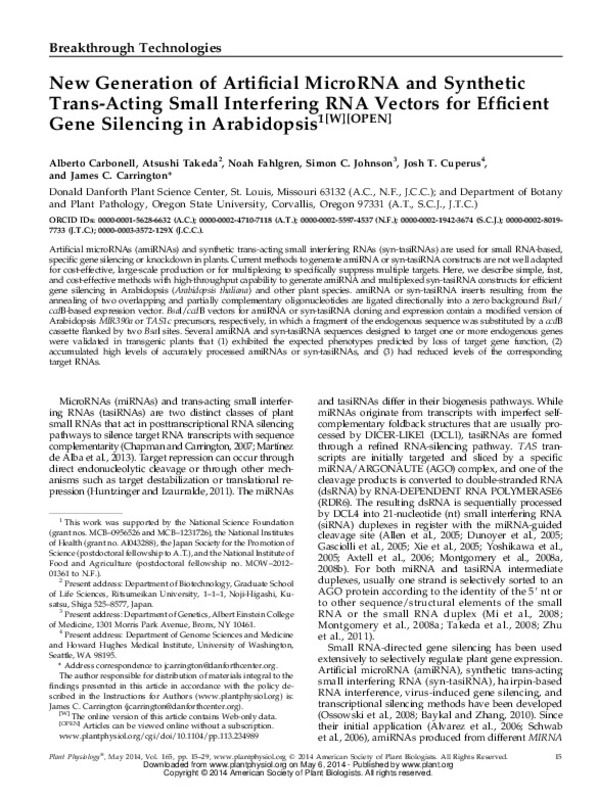JavaScript is disabled for your browser. Some features of this site may not work without it.
Buscar en RiuNet
Listar
Mi cuenta
Estadísticas
Ayuda RiuNet
Admin. UPV
New generation of artificial microRNA and synthetic trans-acting small interfering RNA vectors for efficient gene silencing in Arabidopsis
Mostrar el registro sencillo del ítem
Ficheros en el ítem
| dc.contributor.author | CARBONELL, ALBERTO
|
es_ES |
| dc.contributor.author | Takeda, Atsushi
|
es_ES |
| dc.contributor.author | Fahlgren, Noah
|
es_ES |
| dc.contributor.author | Johnson, Simon C.
|
es_ES |
| dc.contributor.author | Cuperus, Josh T.
|
es_ES |
| dc.contributor.author | Carrington, James C.
|
es_ES |
| dc.date.accessioned | 2021-02-11T04:32:01Z | |
| dc.date.available | 2021-02-11T04:32:01Z | |
| dc.date.issued | 2014-05 | es_ES |
| dc.identifier.issn | 0032-0889 | es_ES |
| dc.identifier.uri | http://hdl.handle.net/10251/161041 | |
| dc.description.abstract | [EN] Artificial microRNAs (amiRNAs) and synthetic trans-acting small interfering RNAs (syn-tasiRNAs) are used for small RNA-based, specific gene silencing or knockdown in plants. Current methods to generate amiRNA or syn-tasiRNA constructs are not well adapted for cost-effective, large-scale production or for multiplexing to specifically suppress multiple targets. Here, we describe simple, fast, and cost-effective methods with high-throughput capability to generate amiRNA and multiplexed syn-tasiRNA constructs for efficient gene silencing in Arabidopsis (Arabidopsis thaliana) and other plant species. amiRNA or syn-tasiRNA inserts resulting from the annealing of two overlapping and partially complementary oligonucleotides are ligated directionally into a zero background BsaI/ccdB-based expression vector. BsaI/ccdB vectors for amiRNA or syn-tasiRNA cloning and expression contain a modified version of Arabidopsis MIR390a or TAS1c precursors, respectively, in which a fragment of the endogenous sequence was substituted by a ccdB cassette flanked by two BsaI sites. Several amiRNA and syn-tasiRNA sequences designed to target one or more endogenous genes were validated in transgenic plants that (1) exhibited the expected phenotypes predicted by loss of target gene function, (2) accumulated high levels of accurately processed amiRNAs or syn-tasiRNAs, and (3) had reduced levels of the corresponding target RNAs. | es_ES |
| dc.description.sponsorship | This work was supported by the National Science Foundation (grant nos. MCB-0956526 and MCB-1231726), the National Institutes of Health (grant no. AI043288), the Japan Society for the Promotion of Science (postdoctoral fellowship to A.T.), and the National Institute of Food and Agriculture (postdoctoral fellowship no. MOW-2012-01361 to N.F.) | es_ES |
| dc.language | Inglés | es_ES |
| dc.publisher | American Society of Plant Biologists | es_ES |
| dc.relation.ispartof | PLANT PHYSIOLOGY | es_ES |
| dc.rights | Reserva de todos los derechos | es_ES |
| dc.title | New generation of artificial microRNA and synthetic trans-acting small interfering RNA vectors for efficient gene silencing in Arabidopsis | es_ES |
| dc.type | Artículo | es_ES |
| dc.identifier.doi | 10.1104/pp.113.234989 | es_ES |
| dc.relation.projectID | info:eu-repo/grantAgreement/NSF//0956526/US/Function of Arabidopsis Small RNA-ARGONAUTE Complexes/ | es_ES |
| dc.relation.projectID | info:eu-repo/grantAgreement/NIH//AI043288/ | es_ES |
| dc.relation.projectID | info:eu-repo/grantAgreement/NSF//1231726/US/Function of Arabidopsis Small RNA-ARGONAUTE Complexes/ | es_ES |
| dc.relation.projectID | info:eu-repo/grantAgreement/NIFA//MOW-2012-01361/ | es_ES |
| dc.rights.accessRights | Abierto | es_ES |
| dc.contributor.affiliation | Universitat Politècnica de València. Instituto Universitario Mixto de Biología Molecular y Celular de Plantas - Institut Universitari Mixt de Biologia Molecular i Cel·lular de Plantes | es_ES |
| dc.description.bibliographicCitation | Carbonell, A.; Takeda, A.; Fahlgren, N.; Johnson, SC.; Cuperus, JT.; Carrington, JC. (2014). New generation of artificial microRNA and synthetic trans-acting small interfering RNA vectors for efficient gene silencing in Arabidopsis. PLANT PHYSIOLOGY. 165(1):15-29. https://doi.org/10.1104/pp.113.234989 | es_ES |
| dc.description.accrualMethod | S | es_ES |
| dc.relation.publisherversion | https://doi.org/10.1104/pp.113.234989 | es_ES |
| dc.description.upvformatpinicio | 15 | es_ES |
| dc.description.upvformatpfin | 29 | es_ES |
| dc.type.version | info:eu-repo/semantics/publishedVersion | es_ES |
| dc.description.volume | 165 | es_ES |
| dc.description.issue | 1 | es_ES |
| dc.identifier.pmid | 24647477 | es_ES |
| dc.identifier.pmcid | PMC4012576 | es_ES |
| dc.relation.pasarela | S\378023 | es_ES |
| dc.contributor.funder | National Science Foundation, EEUU | es_ES |
| dc.contributor.funder | National Institutes of Health, EEUU | es_ES |
| dc.contributor.funder | National Institute of Food and Agriculture, EEUU | es_ES |








